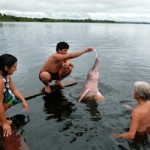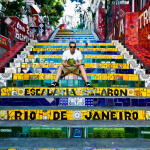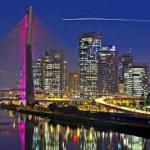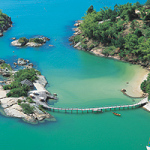STUDY IN BUENOS AIRES, ARGENTINA AND TRAVEL AROUND LATIN AMERICA
Although Buenos Aires can be hard to leave, our Mente Argentina’s participants often take trips around Argentina and to surrounding countries during their time off from class, internships, and volunteering, just to double check that Buenos Aires really is the best. Here Mente participants spill the juice about their travels, sharing special tips on how to do it right.
Iguazu Falls- Hugh
Hugh Fitzpatrick went to Iguazu Falls in style with BAIS, an international student organization, based in Buenos Aires. Other Mente participants attended this trip with Hugh, as well. BAIS runs trips to various nearby hotspots throughout the year. The bus took 24 hours, stopping at the San Ignacio ruins, which he felt were only alright. Along the way, Hugh met people from France, Colombia, United States, Mexico, among numerous other nations. The students played games, danced and sang, while drinking and eating throughout the ride.
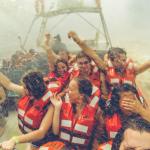 The falls truly blew Hugh away. On the first day, the group took a boat ride underneath the waterfall, becoming engullfed in the falls, a wonderful way to cool off from the sun. Hugh felt that the boat was an intense start to the day, but nonetheless awesome, as was everything in the park. While hiking, the group was able to spread out on the walk way and do their own thing, but they still had a coordinator. This, Hugh felt, was the best of both worlds. “Francois was our coordinator and he was really cool and informative,” Hugh said.
The falls truly blew Hugh away. On the first day, the group took a boat ride underneath the waterfall, becoming engullfed in the falls, a wonderful way to cool off from the sun. Hugh felt that the boat was an intense start to the day, but nonetheless awesome, as was everything in the park. While hiking, the group was able to spread out on the walk way and do their own thing, but they still had a coordinator. This, Hugh felt, was the best of both worlds. “Francois was our coordinator and he was really cool and informative,” Hugh said.
At night, the group returned to their hostels for a short rest and then cooked a huge asado that hostel parrilla. Afterwards, the group went out to a club, with free entry and drink specials from BAIS. The second day at the falls was just as fabulous. The group hiked through the park and then returned home on the “fun bus.” On the way back to Buenos Aires, the group stopped for a guided tour of an amethyst mine.
“If I had any advice, I would say that the Brazilian side was an incredible panoramic and the Argentine side had more atmosphere. You gotta go to both,” Hugh insists.
Everything on this Iguazu trip was centered around the students. It is organized for students living in Buenos Aires to explore a world wonder, while making new friends. There is a Facebook group now, where everyone from the trip swaps photos and makes plans together back in Buenos Aires. “I have many new facebook friends and a number of new real friends, as well,” Hugh jokes.
Hugh especially recommends this trip for people who have just arrived to Buenos Aires and have time. It is a great way to meet people, since a lot of students on the trip are in Buenos Aires for six months, a year, or longer studying.
Check Out Hugh’s Blog about his adventure!
Mendoza – Danielle & Kim
Danielle and Kim traveled to Mendoza with a friend visiting Argentina from the states. They were in Mendoza for three days and two nights, Wednesday through Sunday. They traveled on an overnight bus, using the company Andes Mar on the way, and Cavalier on the way back. Cavalier was much nicer, but more expensive. All bus companies offer different seat options based on levels of comfort. The girls chose Semi-Cama, which is a seat that rotates halfway into a bed. Regional busses are all very easy to book.
They planned their trip on their own, finding their hostel and bus tickets online. They chose Hostel Suites and were not disappointed. The three shared a private room with breakfast included. The hostel also provided them with a spreadsheet, containing a wide range of tours and activities, including hot springs, climbing, hiking, horseback riding, rafting, and more. The hostel recommended activities for each day. Their hostel was walking distance from the city center, as well as all necessary busses.
The girls recommend that people visiting Mendoza book activities in advance, because many tours and excursions were already sold out when they arrived. They attended one wine tour through their hostel and toured vineyards by bike, as well. The girls rented their bikes through Mr. Hugo Bike Trip, and highly recommend it. It is $50 Pesos for the day. The girls met Mr. Hugo and maintain that he is one of the nicest men on earth. There are also tourist police patrolling the area, in case the bike breaks down. These police have spare bikes and there was also fresh food being sold along the road, for reinforcement.
The girls also visited hot springs, which sits at the base of a mountain. “The hot springs were almost a water park and were literally on the side of the mountain. It was amazing. A lot of families were there, as well,” said Kim. The girls especially loved the small family bodegas, which are all easily accessible and very cool. They spent another afternoon at an olive oil orchard and learned how to make olive oil. They also visited a microbrewery and beer garden in the middle of a giant field.
The girls went to a bodega called Familia di Tomasso, still run by the original family who came to Mendoza from Italy. The girls had lunch at the bodega, picking grapes off of vines. “We sat outside, it was beautiful. It was nice to have a meal there and support the family.” The family explained how everything in the orchard and vineyard worked. They host tours in English. Overall the girls tell me that this trip was a dream, nothing but wonderful food, wine, and relaxation.
Calafate – Campbell
Campbell flew from Buenos Aires to El Calafate on a trip to multiple destinations in Patagonia. She spent four days in Calafate, embarking on this adventure with three Italian and three Puerto Rican friends. She met her Italian friends in class at UBA and she met the Puerto Ricans while traveling in Iguazu, clicking with them all immediately.
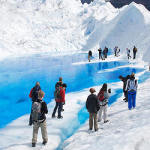 In Calafate, Cam stayed at America del Sur Hostel. “The hostel was awesome,” said Cam. The main attraction in Calafate is the Perito Moreno Glacier. There are two trekking options on the Glacier, a big trek and a small trek. Campbell chose the big trek, which is much more thorough and exciting, although also more difficult and expensive. The larger trek is recommended for the more in shape and adventurous traveler. “It was the most incredible thing I have done in my life, it was crazy, we actually went into the Glacier,” said Campbell. “They provide free gloves, but I definitely recommend renting snow pants!” The big trek is a full seven hour day, which was tiring for Campbell. Everyone brings their own lunch. On the way back, the guides provide everyone with whiskey, in a glass of glacier ice.
In Calafate, Cam stayed at America del Sur Hostel. “The hostel was awesome,” said Cam. The main attraction in Calafate is the Perito Moreno Glacier. There are two trekking options on the Glacier, a big trek and a small trek. Campbell chose the big trek, which is much more thorough and exciting, although also more difficult and expensive. The larger trek is recommended for the more in shape and adventurous traveler. “It was the most incredible thing I have done in my life, it was crazy, we actually went into the Glacier,” said Campbell. “They provide free gloves, but I definitely recommend renting snow pants!” The big trek is a full seven hour day, which was tiring for Campbell. Everyone brings their own lunch. On the way back, the guides provide everyone with whiskey, in a glass of glacier ice.
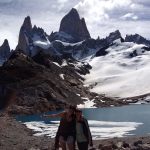 At night, Campbell went to an ice bar. Unlike other ice bars, this hotspot had its floor, walls, glasses, and the bar itself all made of ice. They provide coats and each person has thirty minutes of free drinks. The ice is lit with different colors.
At night, Campbell went to an ice bar. Unlike other ice bars, this hotspot had its floor, walls, glasses, and the bar itself all made of ice. They provide coats and each person has thirty minutes of free drinks. The ice is lit with different colors.
On her last day in Calafate, Campbell and a friend had a private horseback ride with a gaucho. It was entirely different scenery than the glacier, as they rode through the mountains. “On the ride we stopped in a Puma’s den. He wasn’t there, but I left a message,” Campbell jokes.
El Chalten- Hilary
Hilary arrived in El Chalten by bus, from El Calafate. The town itself is small, but extremely charming. La Cervezeria is a hot locale to dine and drink homemade artisanal beer. The town also had a Vinoteca, with a variety of picadas and good food. Hilary was unable to stay in El Chalten for New Years Eve, but she heard that the town has a fabulous outdoor party at the base of the mountains, with a plethora of live music.
El Chalten is most famous for the Fitz Roy mountain peak. “The Fitz Roy and the town of El Chalten itself is one of the most beautiful places I have ever been. It was so stunning and humbling, I don’t even have words,” said Hilary. The hike up and down the Fitz Roy took around seven hours. She recommends bringing hiking shoes and a hiking stick, as she only had sneakers and it was slippery at times. There are beautiful scenic views throughout the entire hike. It is smart to leave early in the morning, as not to risk hiking in the dark.
Hilary stayed in a hostel, which also had camping grounds next to it. She made good friends with the people working there and at night they cooked together and hung out in one of their tents. The locals in El Chalten frequent the few bars, however Hilary stayed around the hostel playing cards, as she experienced enough nightlife in Buenos Aires already.
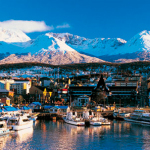 “El Chalten has a strong hiking community,” Hilary adds. Her first day arriving to the hostel, the people working there took her to a local wall, where she watched them boulder (climb without a harnass). Many avid rock climbers move to El Chalten in order to have the opportunity to climb every day. There are some of the best climbing mountains and boulders in the world in and around El Chalten.
“El Chalten has a strong hiking community,” Hilary adds. Her first day arriving to the hostel, the people working there took her to a local wall, where she watched them boulder (climb without a harnass). Many avid rock climbers move to El Chalten in order to have the opportunity to climb every day. There are some of the best climbing mountains and boulders in the world in and around El Chalten.
There were many other hiking options around the town. Hilary hiked during a few afternoons, but only having four days in El Chalten, the Fitz Roy was her biggest accomplishment this time around. “I really hope I get to come back there, the people and the atmosphere in El Chalten are incompatible, and the Fitz Roy’s peak, I will never forget.”
Ushuaia- Campbell
Campbell flew to Ushuaia from El Calafate. “When you land in Ushuaia it is absolutely stunning. But there are not as many excursions,” said Campbell. There is a national park, but Campbell felt that it was not as impressive as the Glacier. There is a sign that says you are in the end of the world and the post office has stamps with the slogan “End of the World”. There is a boat trip through a bay to a pretty island, where you can see sea lions and birds.
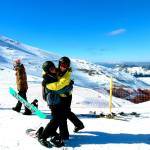 April through June is not the best time to go to Ushuaia, Campbell admits. It is too cold to kayak but too warm for snow activities. Cam went in between seasons. This may have affected her feelings towards Ushuaia. “After you see El Calafate and El Chalten, it is not as great. I almost felt that I went just to say that I went to the end of the world.” Although Ushuaia is a beautiful place to visit, I have heard this same sentiment from others, as well.
April through June is not the best time to go to Ushuaia, Campbell admits. It is too cold to kayak but too warm for snow activities. Cam went in between seasons. This may have affected her feelings towards Ushuaia. “After you see El Calafate and El Chalten, it is not as great. I almost felt that I went just to say that I went to the end of the world.” Although Ushuaia is a beautiful place to visit, I have heard this same sentiment from others, as well.
Bariloche Winter- Campbell
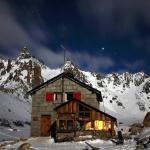 Campbell went to Bariloche at the end of August and beginning of September, at the end of ski season. She traveled with three girls from Mente and they stayed in a hostel, which she found online, ate at restaurants and walked around when she was not skiing. The snow was icy and made from machines because this was the end of the season. She was able to rent all ski equipment on the mountain. This is similar to many other ski vacations, however it is a unique experience to have the opportunity to ski in Bariloche. Mendoza has wonderful skiing, as well!
Campbell went to Bariloche at the end of August and beginning of September, at the end of ski season. She traveled with three girls from Mente and they stayed in a hostel, which she found online, ate at restaurants and walked around when she was not skiing. The snow was icy and made from machines because this was the end of the season. She was able to rent all ski equipment on the mountain. This is similar to many other ski vacations, however it is a unique experience to have the opportunity to ski in Bariloche. Mendoza has wonderful skiing, as well!
Bariloche Summer – Manoela
In the summer, Bariloche offers a plethora of activities. Mente participant Ariel shares that the highlight of her December trip to Bariloche was hiking the Fray. The hike can be done in 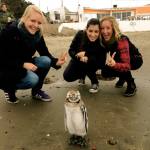 one full day, however, it was more enjoyable to hike to the top more relaxed and stay in the refugio at the top called Refugio Emilio. This refugio is a small cabin with a wood burning fire and kitchen. There is a cat called Emilio, Ariel says, who everyone feeds and plays with. One recommendation is to bring an extra pair of socks and shoes, as your feet get wet crossing a river and trekking through snow towards the top of the mountain. The entire hike is filled with beauty and glorious views. You must bring your own sleeping bag to the refugio, which you may rent in the town of Bariloche.
one full day, however, it was more enjoyable to hike to the top more relaxed and stay in the refugio at the top called Refugio Emilio. This refugio is a small cabin with a wood burning fire and kitchen. There is a cat called Emilio, Ariel says, who everyone feeds and plays with. One recommendation is to bring an extra pair of socks and shoes, as your feet get wet crossing a river and trekking through snow towards the top of the mountain. The entire hike is filled with beauty and glorious views. You must bring your own sleeping bag to the refugio, which you may rent in the town of Bariloche.
Puerto Madryn- Campbell
Puerto Madryn was not originally on Campbell’s hitlist for her time in Argentina, but after traveling there she says it was “By far my favorite place.” Campbell met a guy from the U.S. while traveling in Iguazu and he suggested the destination. She went specifically to swim with sea lions.
To swim with the sea lions, you must join an organized tour. A boat carrying no more than seven people, takes you to an area where the sea lions reside and you can jump off the boat.
The sea lions swam all around Campbell. “I felt something hit me in the back and thought it was my instructor. It was a sea lion and it was not even afraid of me,” Campbell said. The group is shown how to swim in a certain way so that the sea lions follow. The sea lions dove like dolphins around the group.
“They have longest eye lashes, they’re so cute! They bite your hand like little dogs, but they don’t actually hurt you,” Campbell said. The sea lions jumped on Campbell’s stomach and tried to snatch her goggles. However, swimming with sea lions is a definite risk. These animals are wild. Also, it is possible that the group may not see many sea lions, although the boat stops near the sea lion hangout.
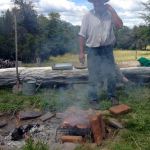 “One sea lion was head butting a girl in the group, banging his head on her and eating the instructors’ face.” There are also Orca Whales in this region, but Campbell’s group did not see any. The company offers free wet suits, as well as dry suits which cost 1,100 pesos. The wetsuit fits over your clothes and you can literally wear a jacket, it goes over your head, and only your face gets wet. Campbell recommends the dry suit, if you do not like to suffer.
“One sea lion was head butting a girl in the group, banging his head on her and eating the instructors’ face.” There are also Orca Whales in this region, but Campbell’s group did not see any. The company offers free wet suits, as well as dry suits which cost 1,100 pesos. The wetsuit fits over your clothes and you can literally wear a jacket, it goes over your head, and only your face gets wet. Campbell recommends the dry suit, if you do not like to suffer.
There were over five hundred penguins in the hills of Puerto Madryn. Signs can be seen throughout the hills saying, ’Penguins Crossing’ and “penguins literally brush up against you and you have to get out of the way. They are everywhere,” said Cam. “We sat and ate lunch and penguins were literally running by my shoulder, it was crazy.” After the middle of April, the penguins migrate to Brazil. Cam also added that the town of Puerto Madryn is much cuter than Calafate and Ushuaia, there was also more to do.
El Bolson- Kelly
Kelly heard about WWOOF while living in Spain in 2011, through a friend, who told her about an organic farm organization that hosted people for free, in exchange for work. Kelly decided to do this for one month that summer in both southern and northern Spain. The organization is separated by country. The membership cost is usually about $35USD/year and after two wonderful experiences in Spain, Kelly decided to become a WWOOF Argentina member during her summer break from her Master’s program, she was doing through Mente.
Transportation wise, Kelly took “the good old bus, all the way.” In January, she took the twenty six hour bus ride to El Bolson and stayed on a dairy farm in Mallin Almohada, north of El Bolson in the Andes, for a month. While there, she learned how to make queso semi-duro, ricotta, and mozzarella cheese. The family was German. The parents of the family came to Argentina over twenty five years ago, separately. After meeting in El Bolson, they decided to raise their family in the Patagonian Andes.
The family sells their cheeses every week, twice a week, at the El Bolson artesian market. Most of Kelly’s days were spent caring for the farm animals very early in the morning. She fed the pigs, chickens, cats, and dogs, and milked the cows. “This was probably my most memorable task, as I have never even come close to touching a cow’s utter before in my life. They milked their cows twice a day by hand and I participated every day. You’d be surprised how difficult it is! I used muscles that I didn’t even know existed in my hands/lower arms, and was even sore for the first week or so. It was definitely an experience,” said Kelly.
The rest of her days were spent either helping cook, taking care of the garden, raking up the pas (grass) to put in the stable for the cows during the winter, and other odd jobs that were needed around the house. It was an incredibly unique experience, as Kelly grew up in suburbs of large cities and never had much contact or knowledge of farm-life or “vida del campo.” During her month-long stay, Kelly worked at least six to eight hours per day, which is much more than the average WWOOFer’s hours. She enjoyed this time greatly, but she was excited to move on to her next WWOOFing location.
Kelly’s second WWOOFing experience was in General Rodriguez, outside of Buenos Aires. She stayed with an Argentine family for two weeks and, “randomly enough, they also had their own dairy farm. I absolutely loved my time at this farm. There were two other wwoofers with me at this farm and we all got along well. The atmosphere here was extremely relaxed and our days consisted of early mornings, long siestas, and late night cooking sessions while chatting in the kitchen. We helped with every meal and even introduced the family to a proper American brunch, complete with thick pancakes, breakfast burritos and hot sauce. I found myself reluctant to leave this wonderful family but after two months away in the tranquil countryside, I was craving the hustle-and-bustle of the BsAs city-life. My desire to escape and be ‘one with my thoughts’ had transformed into a hankering for the perpetual vibrations that Buenos Aires offers. However, this is from someone who is a city-girl at heart,” said Kelly.
Kelly highly recommends WWOOF to anyone who is interested in traveling economically, while learning something new about agriculture and/or sustainable living and forming new bonds with both locals and other foreigners. She can’t wait to do it again!
Salta- Therese
Therese took a Sunday night bus from Buenos Aires to Tucuman, arriving in the morning with 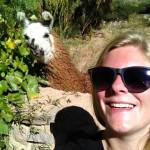 her friends to Tafil Vallee Village, 1000 meters high. She ate a late lunch of humita with cheese and spent the night in the hostel, which had dinner included. They hiked around this area and had a blast. She then took the bus to Salta, where she visited Cafayate, one of Argentina’s most famous vineyards. They found Rusty K Hostel in Lonely Planet, where they stayed for their two nights in Cafayate. They walked around the city in the afternoon and in the morning went to a waterfall and then hiked Cafayate, a bodega wine tastings. She went out for empanadas and wine. After two nights there, she took the bus at 5:00AM to Tulcara in Jujuy, a small village. It was quite touristy, with lots of hostels. Buildings were in all different colors and each day there was something different to do.
her friends to Tafil Vallee Village, 1000 meters high. She ate a late lunch of humita with cheese and spent the night in the hostel, which had dinner included. They hiked around this area and had a blast. She then took the bus to Salta, where she visited Cafayate, one of Argentina’s most famous vineyards. They found Rusty K Hostel in Lonely Planet, where they stayed for their two nights in Cafayate. They walked around the city in the afternoon and in the morning went to a waterfall and then hiked Cafayate, a bodega wine tastings. She went out for empanadas and wine. After two nights there, she took the bus at 5:00AM to Tulcara in Jujuy, a small village. It was quite touristy, with lots of hostels. Buildings were in all different colors and each day there was something different to do.
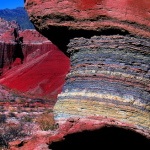 She went to village Purma Marea to watch the sunrise, taking pictures and having breakfast and coffee with her new French friend, whom she met there. She met eight other people in the hostel and shared a taxi to Salinas Grandes, to make the ride cheaper. “You had to cross
She went to village Purma Marea to watch the sunrise, taking pictures and having breakfast and coffee with her new French friend, whom she met there. She met eight other people in the hostel and shared a taxi to Salinas Grandes, to make the ride cheaper. “You had to cross 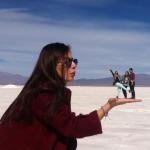 a mountain and back up again 4,100 meters up and it was very worth it. The salt flats were amazing,” Therese gushed.
a mountain and back up again 4,100 meters up and it was very worth it. The salt flats were amazing,” Therese gushed.
In the afternoon, they walked around seven colored rocks, which were different than anything Therese had ever seen, very unique and worth visiting. There was also a really nice market in this area. They later took a bus to Tilcar and the next day, they took a guided tour of the archaeological site Pu Cara, where they saw lamas. They returned to Salta after for a steak dinner. Then she flew to Iguazu. Her highlight in Iguazu she mentioned was an eco tour through a rehab ecological reserve, where animals are rehabilitated to be placed back into nature.
Cordoba- Hannah
Hannah visited Villa Flores, in Cordoba Province, right outside the city of Cordoba. She went for the weekend of Semana Santa, Wednesday through Sunday. It was her first time leaving Buenos Aires, since arriving, so she was more than delighted to soak in the nature and greenery. It was an 18 hour trip by bus, and ten of them spent the weekend in the countryside. They were in a big house in the middle of nowhere, owned by the family of a girl that Hannah had met in Paris the previous year.
The first night, they had a big asado, as most of the crew was Argentine. “It was quite hard speaking Spanish all weekend, but good practice,” Hannah said.
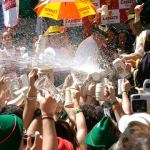 “It was really peaceful right by a mountain range, on the top of a big hill. We saw nothing for ages and there were beautiful sunsets,” Hannah said.
“It was really peaceful right by a mountain range, on the top of a big hill. We saw nothing for ages and there were beautiful sunsets,” Hannah said.
I would like to add that a wonderful time to go to Cordoba is for Oktoberfest. Spirits are high and beer is obviously flowing during this internationally renowned event. Many people rent cars or travel by bus on their own to Cordoba during this time, but going with a group on a party bus is also a very solid choice. Once In Motion offers a highly rated excursion to Oktoberfest each year, which I have heard is a blast and a half.
Uruguay- Gina
Gina gave me the lowdown about Uruguay. As Colonia is only an hour long ferry ride from Buenos Aires, many people come from Buenos Aires to see Colonia for the day. The city has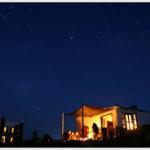 a historic colonial area, beautiful for walking around and people watching at a cafe. The waterfront is lovely as well, however Uruguay’s nicer beaches are further down the coastline. Gina tells me that It is best to travel to the other beaches from Montevideo, a three hour bus ride from Colonia. Popular bus companies are Buquebus, Colonia Express, and Seacat Colonia.
a historic colonial area, beautiful for walking around and people watching at a cafe. The waterfront is lovely as well, however Uruguay’s nicer beaches are further down the coastline. Gina tells me that It is best to travel to the other beaches from Montevideo, a three hour bus ride from Colonia. Popular bus companies are Buquebus, Colonia Express, and Seacat Colonia.
Once in Montevideo, which is a lovely town as well, Gina took the Summer Bus down the coast. She passed Punta del Este, which has beautiful beaches and a roaring nightlife, but is known to be more ritzy and for families. She made her first stop at Cabo Polonio. “Cabo Polonio is truly a hidden gem,” said Gina. The only way to get into the town of Cabo Polonio is by Ox Cart, 4×4 vehicle, or by walking, which could take from an hour a half to three hours. Gina took an ox cart, but heard that walking along the coast is the most beautiful way to get there. Cabo Polonio is unique in that there is no electricity in the town. There are beautiful sand dunes, and only a few cottages and hostels. “Because there is no electricity, the stars are incredible every night.” Although Gina had a wonderful and relaxing time in Cabo Polonio, after a few days, she made her way to Punta del Diablo.
Known for the surfing community and live music, Punta del Diablo is a mecca for young 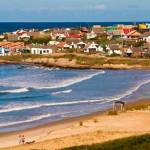 people looking for a relaxing good time. She had a blast in Punta del Diablo, staying at El Diablo Tranquilo Hostel. She met a lot of new friends and even took a surf lesson. “I met a lot of locals, surfers who came there on vacation and never left,” said Gina. She bought a hand woven bag at the market, as well. In the end, she didn’t want to leave, but kissed her friends goodbye, hoping to one day see them again. Like most beach towns in Uruguay, the beach empties out in the winter. Prices also drop during off season.
people looking for a relaxing good time. She had a blast in Punta del Diablo, staying at El Diablo Tranquilo Hostel. She met a lot of new friends and even took a surf lesson. “I met a lot of locals, surfers who came there on vacation and never left,” said Gina. She bought a hand woven bag at the market, as well. In the end, she didn’t want to leave, but kissed her friends goodbye, hoping to one day see them again. Like most beach towns in Uruguay, the beach empties out in the winter. Prices also drop during off season.
Valparaiso- Dara
Dara traveled to Valpo from Santiago by bus, which is only an hour and a half long and $8 USD The busses leave every twenty minutes all day, so it is an easy trip. Dara gushes that Valpo is one of his favorite places in the world, it was hard to leave. I would like to add that most people who visit Valpo are immediately drawn to its magic and mystery. While there, Dara recommends eating a Chorillana, which is fries with egg, onion, and meat. “A great 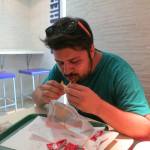 hangover cure,” says Dara. Also, Completos are a must: hot dogs with guacamole and garlic mayonnaise.
hangover cure,” says Dara. Also, Completos are a must: hot dogs with guacamole and garlic mayonnaise.
Dara also insists that anyone who visits Valparaiso, must go on the graffiti tour. “The graffiti in Valpo is amazing and the city is so gorgeous. There are so many colors everywhere,” says Dara. Dara recommends the Valpo Street Art Tour. “The guy who runs this tour is great and knows a lot.”
All of the houses in Valparaiso are different shades of orange, blue, red, green, pink, and 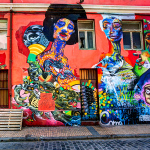 more. It is on the Pacific ocean and the weather is always great. All in all, Valpo is a destination that should be at the top of anyone’s list.
more. It is on the Pacific ocean and the weather is always great. All in all, Valpo is a destination that should be at the top of anyone’s list.
Valparaiso is also known to have some of the best fireworks in the world on New Year’s Eve. The beach becomes filled with people eating, drinking, and watching the show. A recommended hostel is Hostal Barrio Paraiso. The owner is super friendly and the space is to die for. Viña del Mar is only half an hour away and highlighted by its mystical sand dunes, called Dunas de Concon. Both scenic and fun, you may sand board or simply relax. Viña del Mar also sports beautiful beaches, relaxing atmosphere, as well as interesting culture and residents.
Brazil – Ariel
Ariel traveled through South America for four months with an Overland trip called Tucan Travel. This trip went through Brazil, and afterwards Ariel remained in Brazil with her parents, before beginning the Mente Wine Program in Buenos Aires. Ariel’s time in Brazil began in the south, at Foz do Iguacu, and then she made her way up north. The first destination in Brazil after Foz do Iguacu was the Pantanal.
The Pantanal is tropical wetlands, which run through Brazil, Paraguay, and Bolivia. Ariel 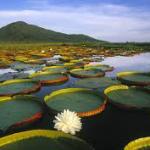 stayed at a campo in the Pantanal for 4 days and 3 nights. “I was super active in the Pantanal,” Ariel said. “I went on boat rides, horseback rides, I went piranha fishing, and on a safari where I saw hundreds of caiman (related to alligators and crocodiles), toucans, parrots and tons of other animals, most of which I had never seen before. At night we slept in a big room filled with hammocks. It was a little hot for my liking but there was more the flora and fauna than anywhere else, which made up for it.” Ariel’s next stop was Bonito.
stayed at a campo in the Pantanal for 4 days and 3 nights. “I was super active in the Pantanal,” Ariel said. “I went on boat rides, horseback rides, I went piranha fishing, and on a safari where I saw hundreds of caiman (related to alligators and crocodiles), toucans, parrots and tons of other animals, most of which I had never seen before. At night we slept in a big room filled with hammocks. It was a little hot for my liking but there was more the flora and fauna than anywhere else, which made up for it.” Ariel’s next stop was Bonito.
Bonito is known for its caves and snorkeling. During a snorkeling trip, Ariel was first taken into the jungle for a giant, Brazilian buffet lunch. After eating, the guides gave her a wetsuit and mask, and walked with her and her group 45 minutes through the jungle. “At the end of the walk, we reached the clearest river that I had ever seen,” Ariel said. Once getting into the river and talking about a few safety precautions, they were free to snorkel as they pleased. “Wearing the wetsuits in the river makes you float, so in order to snorkel all you do is lay completely flat, face down in the water. The current from the river carries you, so all we needed to do was relax and look at the beautiful fish,” said Ariel. While Ariel was snorkeling she was able to hear howler monkeys and other wildlife in the jungle around her. She truly had a wonderful experience. Snorkeling lasted about 3 hours and then the bus took them back to their campsite in town. After leaving Bonito, Ariel traveled to Paraty.
Paraty is a stunning city around four hours south of Rio de Janeiro. In Paraty, there is a 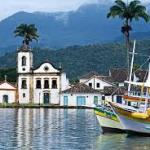 smattering of beautiful beaches and surrounding islands. “We took a party boat one day to a few different islands. At each one, we stopped to get in the water and swim for a bit. Included in the price of the party boat was a lunch on board and all you could drink caipirinhas.” Paraty was one of the most beautiful places Ariel had seen, but it was time to go onto Rio for Carnaval.
smattering of beautiful beaches and surrounding islands. “We took a party boat one day to a few different islands. At each one, we stopped to get in the water and swim for a bit. Included in the price of the party boat was a lunch on board and all you could drink caipirinhas.” Paraty was one of the most beautiful places Ariel had seen, but it was time to go onto Rio for Carnaval.
Ariel Arrived to Rio de Janeiro two days before Carnaval. During one of those days she visited the Botanical Garden. On her way to the Botanical Garden, she and her friend stumbled upon Parque Lage, one of the most stunning parks Ariel had ever seen. After wondering around Parque Lage, they went to Jardin Botanical, which was filled with paths bordered with giant palm trees.
“Rio de Janeiro is truly full of life, especially during Carnaval,” Ariel insists. She stayed in Lapa for Carnaval with her group, and then moved to the Copacabana for her second week in Rio with her parents. Carnaval in Rio was a once in a lifetime experience and Ariel recommends it highly. “Just outside my front door, on the first day of Carnaval was a pop up party. It was wonderful! [There were] hundreds of people dancing out front of my hotel and following the truck where the music was coming from. There were vendors all down the street selling cheap beer and caipirinhas,” Ariel exclaimed. Ariel adds that she wish she had known before arriving how difficult it would be to aquire cash during Carnaval. “This was a hard task, since all of the ATMs were boarded up or empty.” Ariel cautions future Carnaval goers to bring enough cash in advance.
“Going to the Sambadromo was something I will never forget. Hundreds of Brazilians Samba parading through the Sambadrome with the biggest, most creative floats I had ever seen. 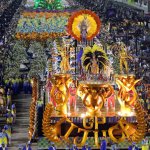 Each night of Carnaval there are about seven different Samba schools that perform. This takes from about 7:00PM to 6:00AM each night. The costumes, the music, the floats, and the people were overwhelmingly passionate and wonderful,” Ariel gushes. The last day of Carnaval, Ariel and her friends went to the Gay Gala. This party was filled with drag queens in extravagant clothing, which are shown off on the runway out front of the venue.
Each night of Carnaval there are about seven different Samba schools that perform. This takes from about 7:00PM to 6:00AM each night. The costumes, the music, the floats, and the people were overwhelmingly passionate and wonderful,” Ariel gushes. The last day of Carnaval, Ariel and her friends went to the Gay Gala. This party was filled with drag queens in extravagant clothing, which are shown off on the runway out front of the venue.
At the end of Carnaval, Ariel’s parents met her in Rio and they visited Christ the Redeemer, which is one of the main symbols of the city. “Being at the top of this giant structure gives you a gorgeous panoramic view of the city,” Ariel said. Ariel highly recommends Restaurante Aprazive. She says it is unique, located in a large tree house in the mountains, with yummy food.
After two weeks in Rio, Ariel and her parents flew to Manaus for a week long jungle cruise, with the company Iberostar. During the cruise, they went on side excursions each morning and afternoon. While on the cruise they enjoyed the pool and unlimited drinks, while looking around at the beautiful scenery. “One of the side trips included going on a small boat with a bag full of fruit in search of monkeys. We ended up finding a troupe of squirrel monkeys and since we had fruit for them, they came onto our boat and we were able to feed them. It was a magical experience having a hundred monkeys surrounding you in the middle of the Amazon,” Ariel gushes. Other excursions included hikes through the jungle, traveling to villages in the middle of the Amazon by boat, and feeding pink Amazonian dolphins.
Once the cruise was over, Ariel and her parents visited the Amazon Opera Theatre located in Manaus. Although Manaus is filled with tourists going to the jungle, Ariel cautions that the city can be dangerous at night. After Manaus, Ariel and her parents flew to Salvador.
Salvador de Bahia is a beautiful beach town, full of life and spunk. While in Salvador, Ariel saw Capoeira (Brazilian dance fighting) performances along the beach. Ariel and her parents stayed in the Pestana Convento do Carmo, a stunning hotel transformed from an old monastery in the historic part of town.
Ariel wishes she had spent more than a few days in Salvador and recommends staying longer. “The warmth from the city was contagious, and I am going back as soon as I get the chance,” Ariel said. Ariel’s last stop in Brazil was Sao Paulo.
Ariel felt that the size of Sao Paulo was overwhelming, but she and her parents had a guide to help them navigate. “We ate at a restaurant called Figueira Rubaiyat which is literally built around a giant tree in the middle of the restaurant. The food and atmosphere were fantastic,” Ariel said.
“Brazil was absolutely one of my favorite countries. It is filled with the kindest, most passionate, and most beautiful people. I cannot wait to return for another visit.”
Brazil – Fred
Fred is a Brazil veteran. He has been traveling there each year for years and plans to continue this trend. “The girl from Ipanema goes walking, and when she passes, each one she passes goes – ah…” This is one of the most famous songs from Brazil, Fred tells me. He explains that and while is true that the country has recently hosted the World Cup, is also preparing for the Rio de Janeiro Olympics in 2016, and has the most beautiful women, the country itself is unique in its diverse beauty. From the beaches of Rio and Bahia, the jungles of Amazon, the falls of Iguazu, to a plethora of metropolitan cities in addition Rio and Sao Paulo, there is truly no place like Brazil.
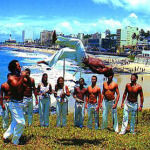 “But let us start from the beginning,” said Fred. “Without a doubt the most famous city of Brazil is Rio de Janeiro, a cidade maravilhosa (the wonderful city), as is known by the locals proudly. With the iconic Cristo Redentor, one of the seven wonders of the modern world), pao de açúcar, the Maracanã, and el Parque Nacional de Tijuca, which is one of the biggest urban forests in the world,” Fred explained. “The city has improved a lot in a really short time, due to economic growth and the big responsibilities ahead, especially in the safety area pacifying the most dangerous favelas in Rio, and making it look a lot cleaner and just more prettier than already is,” said Fred.
“But let us start from the beginning,” said Fred. “Without a doubt the most famous city of Brazil is Rio de Janeiro, a cidade maravilhosa (the wonderful city), as is known by the locals proudly. With the iconic Cristo Redentor, one of the seven wonders of the modern world), pao de açúcar, the Maracanã, and el Parque Nacional de Tijuca, which is one of the biggest urban forests in the world,” Fred explained. “The city has improved a lot in a really short time, due to economic growth and the big responsibilities ahead, especially in the safety area pacifying the most dangerous favelas in Rio, and making it look a lot cleaner and just more prettier than already is,” said Fred.
“As soon as you get in Rio, you will find that Cariocas (Rio natives) are a lot of fun, always smiling, dancing samba, and partying it up and it is a simply contagious, perfect place to get your tan on while sipping on an amazing caipirinha. You will also find that besides the fact that there are a lot of great bodies, no matter if you are skinny or curvy, you are totally entitled to use a bikini/speedo, short shorts and your havainas at all times anywhere,” Fred gushes.
“One of the places that I really love in Rio is Santa Tereza, that’s a taste of the real thing without being too edgy. Please don’t go to the favelas alone just to prove a point,” Fred warns. Santa Tereza is on a hill, in the center of Rio and it is full of cute little bars and restaurants. The famous colorful stairs, cobble stones streets, and walls filled with street art are located here. Fred advises to try pao de queijo and açaí while here. “Trust me, just do it, you will thank me later,” Fred said. Fred also adds that New Years Eve in Rio is magical. Everyone on the beach dresses in white, shares everything, and throws roses to Limanja, the goddess of the sea, at midnight. People jump the first seven waves that come after midnight, asking for seven wishes. “Only seven, I know right,” Fred jokes. He also says that during Carnaval, you can find a party on every single street.
“Sao Paulo is a whole different story,” said Fred. Sao Paulo is five hours from Rio by bus and one of the biggest cities in South America. “Think of New York of Brazil,” Fred said “Everyone goes there to make it big, it is very cosmopolitan and the wealthiest city of Brazil, so you will find it easier to be understood in English and you won’t need to use sign language. It is known by the locals as the concrete jungle, and Sao Paulo is very famous for the architecture, museums, big park (ibirapuera park), and a wonderful nightlife, full of nice places to eat and drink.”
“One of the most fun places is definitely Rua Augusta, a couple of blocks full of bars, but you will actually see everyone in the streets just hanging out listening to music and drinking, then Vila Madalena is a fancy cool neighborhood, the place to be if you are looking for a nice place to eat. Also, walk around Avenida Paulista to find the famous museums like MASP and the Botanical Gardens. Oh by the way, Sao Paulo holds the biggest gay pride in the world.”
South of Sao Paulo, in Santa Catarina State is Florianopolis. “The beautiful island is very close to the shore and there is just one bridge to get to the island. It is a very safe city with a very high quality of life, holding the highest human development index in the country,” Fred said. Florianopolis has approximately 42 beaches, the most famous being Jurere International Beach, Prai dos Ingleses, Joaquin. “Another cool thing about Floripa, how the locals call it, is the dunes. You can surf the waves and the sand,” Fred said. In the city center, you will find a historical center with colonial architecture, museums and churches,” Fred said. “I will just never get sick of Brazil.”


